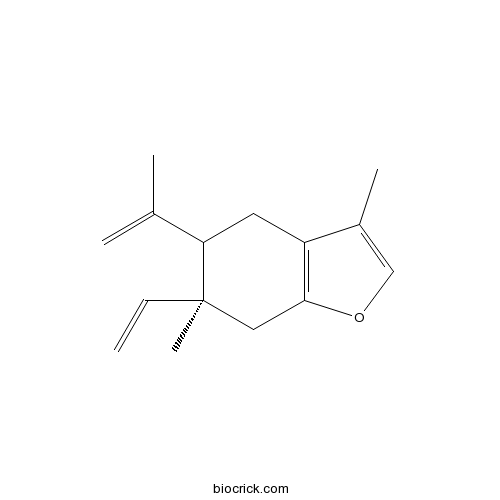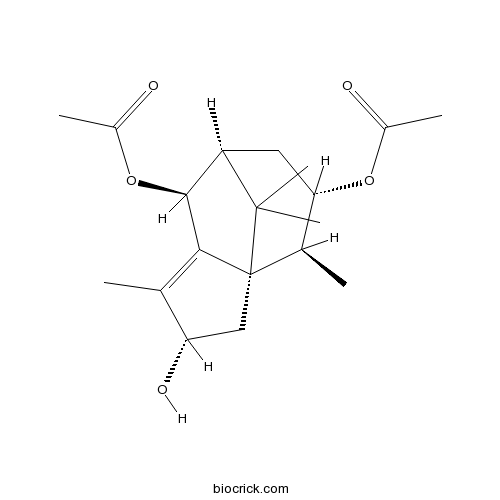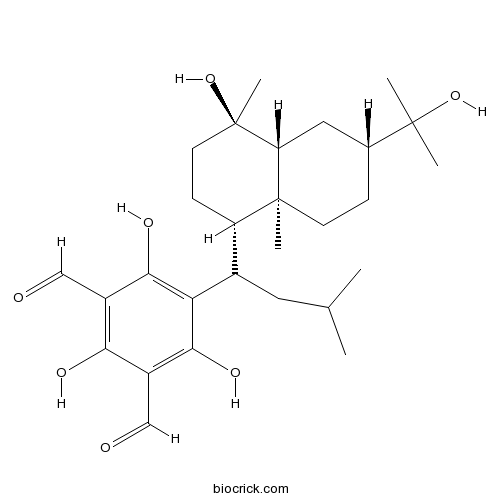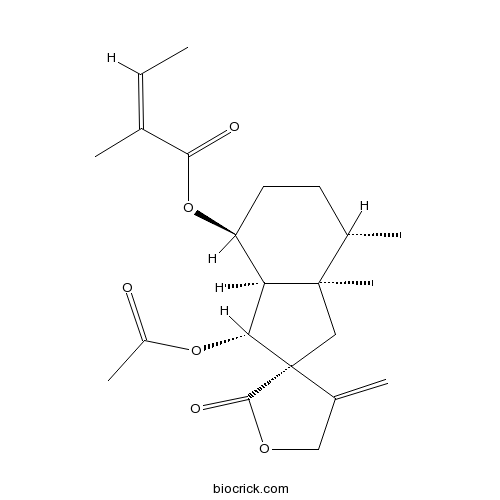Products for Sesquiterpenoids
-
BCN1727
Brevilin A
Brevilin A is a sesquiterpene lactone isolated from Centipeda minima with anti-tumor activity. Brevilin A is a selective inhibitor of JAK-STAT signal pathway by attenuating the JAKs activity and blocking STAT3 signaling (IC50 = 10.6 µM) in Cancer Cells. Brevilin A induces apoptosis and autophagy via mitochondrial pathway and PI3K/AKT/mTOR inactivation in colon adenocarcinoma cell CT26.(CAS NO.:16503-32-5)

-
BCN7880
Shizukaol E
Botanical source: The herbs of Chloranthus japonicus(CAS NO.:165171-09-5)

-
BCN7879
Shizukaol G
Botanical source: The herbs of Chloranthus japonicus(CAS NO.:165171-11-9)

-
BCN3095
Triptonine B
Triptonine B, a sesquiterpene pyridine alkaloid that isolated from Tripterygium hypoglaucum and Tripterygium wilfordii, inhibits HIV replication in H9 lymphocytes with an EC50 value of <0.10 μg/mL.(CAS NO.:168009-85-6)

-
BCN7350
Iso-cuparenal
Botanical source: The herbs of Lepidozia reptans(CAS NO.:16982-01-7)

-
BCN3559
Curcolone
Botanical source: The rhizomes of Curcuma zedoaria(CAS NO.:17015-43-9)

-
BCN7528
4-(6-Methyl-4-oxohept-5-en-2-yl)cyclohex-2-en-1-one
Botanical source: The rhizomes of Curcuma longa(CAS NO.:170380-68-4)

-
BCN7532
1,4-Epidioxybisabola-2,10-dien-9-one
Botanical source: The leaves of Alpinia intermedia.(CAS NO.:170380-69-5)

-
BCN6890
Dihydroactinidiolide
Dihydroactinidiolide, existing in plant leaves and fruits, is a potent plant growth inhibitor, a regulator of gene expression and is responsible for photo acclimation in Arabidopsis. Dihydroactinidiolide has antioxidant activity, antibacterial activity, anticancer activity and neuroprotective effect.(CAS NO.:17092-92-1)

-
BCN1111
Eucalyptone
Botanical source: The branch of Eucalyptus globulus(CAS NO.:172617-99-1)

-
BCN1121
Carabrone
Carabrone is isolated from the fruits of Carpesium abrotanoides , is a well-known sesquiterpene and exhibits significant anti-bacterial and anti-tumor activities. Carabrone exhibits antifungal activities in vitro and in vivo against Botrytis cinerea, Colletotrichum lagenarium(EC50=7.10 μg/mL) and Erysiphe graminis.(CAS NO.:1748-81-8)

-
BCN6733
Wedelialactone A
Botanical source: The herbs of Wedelia trilobata(CAS NO.:175862-40-5)

-
BCN7460
12-Hydroxy-6-epi-albrassitriol
Botanical source: The cultures of Aspergillus sp (FH-A 6357).(CAS NO.:178330-78-4)

-
BCN7342
6-epi-Albrassitriol
Botanical source: The A spergillussp.(CAS NO.:178456-58-1)

-
BCN2352
Curzerene
Curzerene is a sesquiterpene is isolated from the rhizome of Curculigo orchioides Gaertn with anti-cancer activity. Curzerene inhibits glutathione S-transferase A1 (GSTA1) mRNA and protein expression. Curzerene induces cell apoptosis.(CAS NO.:17910-09-7)

-
BCN6960
Sugetriol 6,9-diacetate
Botanical source: The(CAS NO.:17928-63-1)

-
BCN1137
Macrocarpal H
Botanical source: The branch of Eucalyptus globulus(CAS NO.:179388-53-5)

-
BCN1138
Macrocarpal I
Botanical source: The branch of Eucalyptus globulus(CAS NO.:179388-54-6)

-
BCN7105
Leucodin
Botanical source: The roots of Scorzonera latifolia (Fisch. and Mey.) DC.(CAS NO.:17946-87-1)

-
BCN1139
Macrocarpal J
Botanical source: The branch of Eucalyptus globulus(CAS NO.:179603-47-5)

-
BCN6511
Megastigm-7-ene-3,4,6,9-tetrol
Botanical source: The herbs of Apollonias barbujana(CAS NO.:180164-14-1)

-
BCN7606
Anthracophyllone
Botanical source: The metabolites of the mushroom Anthracophyllum sp. BCC18695.(CAS NO.:1801750-22-0)

-
BCN7776
Dibritannilactone B
Botanical source: The aerial parts of Inula britannica.(CAS NO.:1829580-18-8)

-
BCN7207
Bakkenolide B
Botanical source: The leaves of Peatasites japonicus.(CAS NO.:18455-98-6)

-
BCN7114
1-Oxobakkenolide S
Botanical source: The roots of Petasites formosanus(CAS NO.:18456-02-5)






























